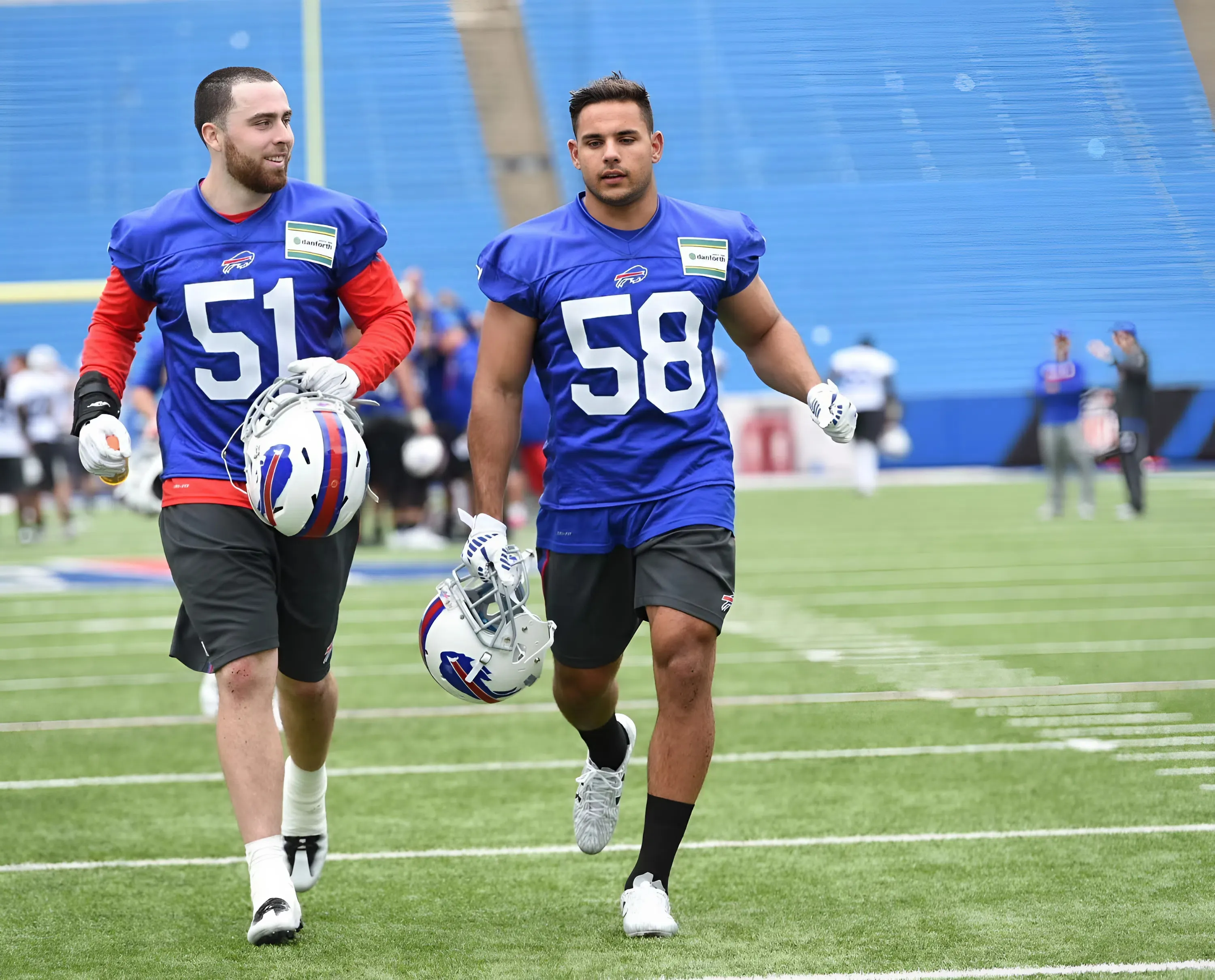A famous thinker once said, “The only that is permanent in life is impermanance.” Sounds like Plato or Descartes, right? Well, it was actually Thor from the Marvel Cinematic Universe. But it still reads well, and it definitely still applies to most situations, including life as a fan of the Vancouver Canucks.
GM Patrik Allvin and Co. of the Canucks made a trade earlier this past week, sending Dakota Joshua to the Toronto Maple Leafs in exchange for a fourth-round pick. It was a transaction aimed almost entirely at freeing up roster and cap space for the 2025/26 season, and it certainly accomplished that goal.
Most believe that space is going to be spent in the stretch of time between now and the opening of Training Camp 2025 in September. And they’re probably not wrong to think so. A number of free agents remain on the market, including Jack Roslovic, who the Canucks have been tied to numerous times. There’s also always the possibility of closing another summer trade.
But the option remains for the Canucks to ‘stand pat,’ so to speak, and to stick with the setup they’ve got on hand now, at least for the start of 2025/26. In fact, not only is that a possibility, but it’s a possibility with some distinct benefits for the team as a whole.
Setting Up a Competitive Training Camp
We took a look at the Canucks’ depth chart post-Joshua earlier in the week and came up with something that looks like this:
Forwards
DeBrusk ($5.5M) – Pettersson ($11.6M) – Boeser ($7.25M)
Höglander ($3M) – Chytil ($4.44M) – Kane ($5.13M)
O’Connor ($2.5M) – Blueger ($1.8M – Garland ($4.95M)
Karlsson ($775K) – Räty ($775K) – Sherwood ($1.5M)
Bains ($775K)
Defence
Hughes ($7.85M) – Hronek ($7.25M)
M. Pettersson ($5.5M) – Myers ($3M)
E. Pettersson ($838K) – Willander ($950K)
Forbort ($2M) – Mancini ($870K)
Goaltending
Demko ($5M)
Lankinen ($4.5M)
And if that is indeed the same roster that makes it to September, there’s a lot to like about it.
This depth chart allows space for the Canucks’ most exciting and most accomplished young players to directly compete for – and actually earn – jobs. With this depth chart, all of Aatu Räty, Linus Karlsson, and Arshdeep Bains should make the cut, along with whichever of Tom Willander or Victor Mancini the team wants to keep up.
Injuries inevitably happen, sure, and sometimes in the preseason. Were that to occur with the depth chart, all it would mean is someone else – like a Max Sasson or a Danila Klimovich – getting an earlier shot at more NHL ice-time than anticipated.
Having a roster where the Abbotsford contingent isn’t actively blocked by a bunch of new warm bodies is a plus both for those who want to see a competitive camp and for those who wish for those players’ championship run to be justly rewarded.
Injury Call-Up Space
Speaking of injuries…
That depth chart above carries a projected cap hit of $93,225,000, once Oliver Ekman-Larsson and Ilya Mikheyev’s $5,479,167 worth of dead cap is added to the total. That leaves the Canucks with some $2,275,000 in projected cap space under the new $95,500,000 ceiling.
In our previous article, we wrote about the possibility of using this space to improve the roster, and that will probably happen at some point or another in some fashion or another.
But for the time being, that extra bit of cap space could prove quite useful when it comes to covering short-term injuries.
Remember, NHL teams only get cap relief for long-term injuries – meaning injuries of either ten games or 24 games in length, or more – and that using this relief space comes with some disadvantages, like an inability to accrue additional cap.
To cover short-term injuries and the call-ups needed to replace them, teams need at least a little extra wiggle room.
With more than $2 million in space, the Canucks could be free to call up any two players from Abbotsford at any time – so long as IR placement opens up the roster space – without having to worry about demoting anyone to clear cap.
That’s not a bad option to keep on the table all season long, if a team can manage it. Over time, that extra space can come from accrual, but early on in the season, it’s got to be carved directly out of the books.
Bonus Cushion Space
There’s also something to be said about saving cap space to accommodate various ELC performance bonuses.
The Canucks don’t have a lot of eligible bonuses around for 2024/25. The younger Elias Pettersson is a good bet to hit his full $80K. Willander famously held out for extra bonuses, and so it stands to reason that he intends to hit close to his maximum $500K. Mancini has $80K of his own, Jonathan Lekkerimäki has up to $450K, and a small handful of others could factor in at various points in the season.
If a team winds up not having enough cap space to cover earned bonuses, the cap from those bonuses can be rolled over to the next season. But that’s never ideal, and it’s always best to cover them in the present moment if possible.
As well, there can be some complications in calling someone with bonuses up mid-season. In short, when that happens and the team is using LTIR, the team needs to have enough cap on hand to cover their full array of possible bonuses – or the call-up can’t happen.
This is all avoided by simply having those players on the opening day roster, thus creating a potential bonus cushion. With lots of cap space on hand, the Canucks can engineer a roster with Willander and Lekkerimäki both on it – even if they don’t actually ‘make the team’ – and thus maintain the largest possible bonus cushion and maintain maximum call-up flexibility throughout the season.
Accruing Cap Space Over Time
You may have heard that the concept of ‘papering’ players down to the minors has ended as of the new CBA, and it’s true. Now, players re-assigned to the AHL must play at least one game there before returning. That ends the practice of the Canucks constantly re-assigning players on off-days just to accrue a little extra cap space.
Or, we should say, that ends the practice…as of 2026/27. The new CBA doesn’t kick in until after this season, so it’s back to Abbotsford business as usual for this year.
That $2,275,000 in current cap space should accrue nicely on its own. The way this works, in short, is that players acquired mid-season already have most of their cap hit off the books, so they’re easier to fit under a season-long cap of $95,500,000. To oversimplify it, if a team acquires a $10 million player with a quarter of the season left, they’ve only got to have $2.5 million of that $95.5 million available.
Were the Canucks to sit on that $2,275,000 in cap space all season long, it’d accrue to the point that they’d be able to add more than $10 million in cap space by the Trade Deadline.
That won’t actually happen, of course, with injuries, call-ups, and eventual acquisitions getting in the way. Until then, however, the Canucks can both continue to accrue and continue to do the sneaky sort of paper transactions on off-days that help them accrue even more.
For 2025/26, there aren’t nearly as many waiver-exempt individuals on hand, but there are the trio of Pettersson, Willander, and Mancini on the back-end. Expect them to be making plenty of day-trips to Abbotsford for as long as the Canucks remain in the business of accruing cap.
Keeping Room Available for In-Season Trades
This is the big one.
It stands to reason that there is not currently a 2C available for a price that the Canucks are willing to pay.
If there were, they’d probably have already paid it by now.
There are players available, of course. The aforementioned Roslovic has got plenty of attention as a forward who can play centre, albeit with limited effectiveness.
But it’s also true that more players will become available later, and that could include either a better 2C than is available now – or one of the same 2Cs, but available at a better price.
The 2024/25 season saw centres like Lars Eller, Jack Drury, Morgan Frost, JT Miller, Filip Chytil, Mikael Granlund, Trent Frederic, Yanni Gourde, Brock Nelson, Dylan Cozens, Josh Norris, Charlie Coyle, and Logan Stankoven all move via trade.
No, those aren’t all legitimate 2Cs. But it’s a lot of centres traded all the same, and enough to suggest that some more should certainly shake loose in 2025/26.
Keeping cap space, roster space, and tradeable assets on hand for the eventuality of another player becoming available seems like smart business for a team in the Canucks’ position, and they’re currently set up to do exactly that – if they don’t rush into another move just for the sake of it in the waning days of summer.
Keeping the 2026/27 Books Free and Clear
The NHL’s cap ceiling jumped more than $7 million this offseason. But the Canucks barely felt that, with the increase entirely consumed by raises to the likes of Brock Boeser, Marcus Pettersson, Nils Höglander, Drew O’Connor, and – most troubling of all – Oliver Ekman-Larsson’s buyout all conspiring to take up all that extra space and then some.
It would be nice for the Canucks to more fully take advantage of the further $8.5 million coming for the summer of 2026. They’ll have a few pending free agents at that point, like Kiefer Sherwood and Evander Kane, but nobody who is going to break the bank. There’s Thatcher Demko’s raise to consider, but it’s manageable.
As it stands now, the Canucks are set to have some $20 million or more in cap space under the $104 million projected ceiling of 2025/26. It’s not a bad thing at all to leave that space open as long as possible, so that the Canucks can have a greater opportunity to explore the myriad ways in which they might use it.
-1752165454-q80.webp)


